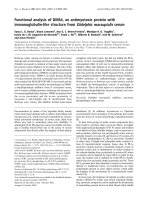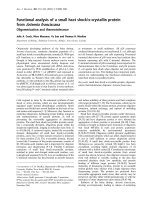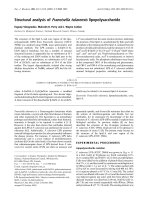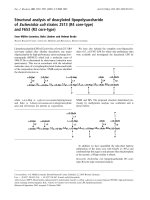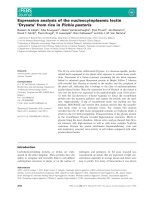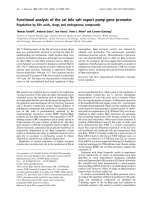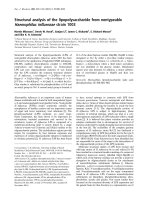Báo cáo y học: "Expression analysis of three isoforms of hyaluronan synthase and hyaluronidase in the synovium of knees in osteoarthritis and rheumatoid arthritis by quantitative real-time reverse transcriptase polymerase chain reaction" potx
Bạn đang xem bản rút gọn của tài liệu. Xem và tải ngay bản đầy đủ của tài liệu tại đây (203.75 KB, 7 trang )
Open Access
Available online />R514
Vol 6 No 6
Research article
Expression analysis of three isoforms of hyaluronan synthase and
hyaluronidase in the synovium of knees in osteoarthritis and
rheumatoid arthritis by quantitative real-time reverse
transcriptase polymerase chain reaction
Mamoru Yoshida
1
, Shigaku Sai
1
, Keishi Marumo
1
, Takaaki Tanaka
1
, Naoki Itano
2
, Koji Kimata
2
and
Katsuyuki Fujii
1
1
Department of Orthopaedic Surgery, The Jikei University School of Medicine, Tokyo, Japan
2
Institute for Molecular Science of Medicine, Aichi Medical University, Aichi, Japan
Corresponding author: Mamoru Yoshida,
Received: 2 Oct 2003 Revisions requested: 30 Oct 2003 Revisions received: 28 Jun 2004 Accepted: 16 Jul 2004 Published: 22 Sep 2004
Arthritis Res Ther 2004, 6:R514-R520 (DOI 10.1186/ar1223)
http://arthr itis-research.com/conte nt/6/6/R514
© 2004 Yoshida et al.; licensee BioMed Central Ltd.
This is an Open Access article distributed under the terms of the Creative Commons Attribution License ( />2.0), which permits unrestricted use, distribution, and reproduction in any medium, provided the original work is cited.
Abstract
Hyaluronan is a major molecule in joint fluid and plays a crucial
role in joint motion and the maintenance of joint homeostasis.
The concentration and average molecular weight of hyaluronan
in the joint fluids are reduced in osteoarthritis and rheumatoid
arthritis. To elucidate the underlying mechanism, we analyzed
the message expression of three isoforms of hyaluronan
synthase and hyaluronidase from knee synovium, using real-time
reverse transcriptase polymerase chain reaction. Synovia were
obtained from 17 patients with osteoarthritis, 14 patients with
rheumatoid arthritis, and 20 healthy control donors. The
message expression of hyaluronan synthase-1 and -2 in the
synovium of both types of arthritis was significantly less than in
the control synovium, whereas that of hyaluronidase-2 in the
synovium of both arthritides was significantly greater than in the
control synovium. The decreased expression of the messages
for hyaluronan synthase-1 and -2 and/or the increased
expression of the message for hyaluronidase-2 may be reflected
in the reduced concentration and decreased average molecular
weight of hyaluronan in the joint fluids of patients with
osteoarthritis and rheumatoid arthritis.
Keywords: arthritis, hyaluronan, hyaluronan synthase, hyaluronidase, synovium
Introduction
High-molecular-weight (HMW) hyaluronan (average molec-
ular weight 6–7 × 10
6
Da) is a major component of synovial
joint fluids [1-5]. It physically acts as a viscous lubricant for
slow joint movements, such as walking, and as an elastic
shock absorber during rapid movements, such as running
[6]. HMW hyaluronan has a variety of biologic effects on
cells in vitro, such as: the inhibition of prostaglandin E
2
syn-
thesis and the release of arachidonic acid induced by inter-
leukin-1 from cultured fibroblasts [7,8]; protection against
proteoglycan depletion and cytotoxicity induced by oxygen-
derived free radicals, interleukin-1, and mononuclear-cell-
conditioned medium [9,10]; and the suppression of phago-
cytosis, of locomotion, and of enzyme release by leukocytes
and macrophages [11-14]. HMW hyaluronan has been
shown to suppress the degradation of cartilage matrix
induced by fibronectin fragments [15,16] and cytokines
[17]. Moreover, it has been shown to relieve joint pain by
masking free nerve ending organelles in animal experiments
[18,19]. Hence, it is suggested that HMW hyaluronan is an
indispensable component in the maintenance of articular
joint homeostasis. Reductions in the concentration and
average molecular weight of hyaluronan in knee synovial flu-
ids from patients with osteoarthritis (OA) or rheumatoid
arthritis (RA) have been reported [2,3,20-25]. These reduc-
tions indicate hyaluronan's involvement in the pathogenesis
of these joint disorders and are reflected in the pathological
changes of hyaluronan metabolism.
HAS-1/-2/-3 = hyaluronan synthase-1/-2/-3; HMW = high-molecular-weight; HPLC = high-performance liquid chromatography; OA = osteoarthritis;
PCR = polymerase chain reaction; RA = rheumatoid arthritis; RT-PCR = reverse transcriptase polymerase chain reaction; SD = standard deviation.
Arthritis Research & Therapy Vol 6 No 6 Yoshida et al.
R515
Hyaluronan is synthesized by hyaluronan synthases (HASs)
located at the plasma membrane of cells [26]. Three HAS
isoforms, encoded by three distinct genes, are expressed
in human knee synovium [27]. It is believed that joint fluid
hyaluronan is mainly supplied from type B cells – proper
synoviocytes – of the synovial lining [2-5,28]. Little is
known about hyaluronan catabolism in synovial fluid. It is
thought that hyaluronan is eliminated by the lymphatic or
vascular system after fragmentation by an unknown proc-
ess [29] or that macrophagic type A cells of the synovial lin-
ing absorb and digest hyaluronan, because type A cells
have many vesicles and vacuoles containing lysosomal
enzyme – such as nonspecific esterase, acid phosphatase,
and cathepsins B, D, and L – and type A cells are active in
the uptake of substances in synovial fluids [28]. Hyaluroni-
dase, which specifically degrades hyaluronan, is a lyso-
somal enzyme. Among five homologous isozymes in
humans, hyaluronidase-1, -2, and -3 are thought to be
expressed in synovium and involved in hyaluronan degrada-
tion, since hyaluronidase-4 is a chondroitinase and hyaluro-
nidase-5, the sperm-specific enzyme PH-20, is specifically
expressed in sperm [30]. The messages of hyaluronidase-
1, -2, and -3 are expressed in chondrocyte monolayer cul-
tures and in extracts of fresh human cartilage [31].
In the present study, we investigated message expression
levels for three isoforms of HAS and hyaluronidase in knee
synovium obtained from control donors and patients with
OA or RA, by quantitative reverse transcriptase polymerase
chain reaction (RT-PCR), in order to confirm whether mes-
sage levels differed.
Materials and methods
Materials
An RNeasy kit was purchased from QIAGEN KK (Tokyo,
Japan). Primer Express computer software, gene-specific
primer pairs and probes, TaqMan Gold RT-PCR reagents
without controls, Pre-Developed TaqMan assay reagents of
endogenous control human beta-actin, and a 7700
sequence detector were purchased from Perkin-Elmer
Corp (Norwalk, CT, USA). The Hyaluronate-Chugai test kit
was from Chugai Pharmaceutical Corp (Tokyo, Japan).
Patients and controls
Baseline data for patients with OA or RA and for control
donors from whom synovial samples were obtained are
summarized in Table 1. Two of us (MY and SS), both phy-
sicians, clinically diagnosed OA and diagnosed RA accord-
ing to the criteria of the American Rheumatism Association.
Pharmacological treatment before sampling was limited to
analgesics or nonsteroidal anti-inflammatory drugs in all
study subjects. Rheumatoid arthritis patients were classi-
fied in stage II or stage III, and class II grade according to
the Steinbrocker classification. The radiographic grades of
all knee joints were determined on frontal views of the tibi-
ofemoral joints according to the radiographic atlas recom-
mended by the Osteoarthritis Research Society [32].
Grade B radiographic appearance, corresponding to grade
1 of the Larsen grading system, is defined by the presence
of grade 1 joint space narrowing combined with osteo-
phytes, or of grade 2 or 3 joint space narrowing. Control
synovial samples were obtained from donors who had no
intra-articular pathologic findings under arthroscopy at sec-
ond-look observations after partial meniscectomy or from
donors who complained of knee pain of unknown etiology
but who had no intra-articular pathologic findings under
arthroscopy on routine examination. The control synovium
donors were significantly younger than the patients with
OA or RA (P < 0.01).
Sampling of synovial tissues and isolation of total
ribonucleic acid
We obtained informed consent from all the study subjects
and approval by the university ethical committee and the
institutional review board. Synovial tissue samples were
obtained from the central area of the suprapatellar pouches
of the knees during arthroscopic examination, arthroscopic
surgery, or open surgery performed in a hospital of the Jikei
University School of Medicine. After subsynovial or fatty tis-
sues were macroscopically resected from the obtained
samples, all synovial samples were immediately frozen with
liquid nitrogen and stored at -80°C. The total RNA of each
sample was isolated using an RNeasy kit.
Analysis of hyaluronan in joint fluid
Joint fluid was aspirated from the knee immediately before
an examination or surgery and was stored at -80°C. Joint
fluid was obtained from 10 healthy control donors, 10
patients with OA, and 10 with RA. Hyaluronan concentra-
tion in joint fluid was measured by a sandwich binding pro-
tein assay using a Hyaluronate-Chugai test kit [33]. The
molecular weight of hyaluronan was calculated from the
intrinsic viscosity of hyaluronan in fluid, which was meas-
ured with a capillary viscometer [34] after pronase treat-
ment. This method was chosen because it is more precise
than HPLC analysis for the measurement of the average
molecular weight of HMW hyaluronan.
Analysis of message expression by quantitative real-
time RT-PCR
Message expression in the synovium of knees and the rela-
tive differences in message levels between the control
group and patients with OA or RA were determined by real-
time RT-PCR in accordance with the manufacturer's
instructions and reported methods [35-39]. The gene-spe-
cific PCR oligonucleotide primer pairs and gene-specific
oligonucleotide probes labelled with a reporter fluorescent
dye (FAM) at the 5'-end and a quencher fluorescent dye
(TAMURA) at the 3'-end were designed using the Primer
Express computer software for HAS-1, -2, and -3 and
Available online />R516
hyaluronidase-1, -2, and -3 genes. For the HAS-2 probe, a
minor groove binder probe was used to achieve an optimal
melting temperature, because a suitable site for the regular
probe was not found in the DNA sequences of HAS-2
(Table 2). A minor groove binder is an enhancer of the
probe's melting temperature. Total RNA (200 ng for each)
was added to a 50 µL RT-PCR reaction buffer containing
0.2 mmol/L deoxynucleotide triphosphates, 1.5 mmol/L
MgSO
4
, 2.5 µmol/L random hexamers, 0.1 U/mL Multi-
Scribe reverse transcriptase, 0.1 U/µL AmpliTaq Gold
DNA polymerase, 900 nmol/L concentration of PCR primer
pairs, 200 nmol/L concentration of the corresponding
probe, and 2.5 µL Pre-Developed TaqMan assay reagents
of endogenous control human β-actin, which contained β-
actin-specific primers and probes labeled with a different
reporter fluorescent dye (VIC). RT-PCR was carried out in
a 96-well plate under the following conditions: one cycle at
50°C for 2 minutes to activate the uracil N-glycosylase, one
cycle at 60°C for 30 minutes, one cycle at 95°C for 5 min-
utes, and 50 cycles at 95°C for 20 seconds and 60°C for
1 minute. The fluorescence energy emitted from the
reporter dye without a quencher was monitored directly by
Table 1
Baseline data for subjects with osteoarthritis (OA) or rheumatoid arthritis (RA) or without arthritis
Age (years)
Subjects Number (male/female) Mean ± SD Range
Radiographic grade
a
With OA 17 (9/8) 64.77 ± 9.02 45 – 83 B
With RA 14 (2/12) 60.55 ± 12.05 35 – 74 B
Controls 20 (11/9) 37.25 ± 7.59 29 – 59 Normal
a
Determined on x-ray frontal views of the tibiofemoral joints in accordance with the radiographic atlas recommended by the Osteoarthritis
Research Society [32]. SD, standard deviation.
Table 2
Sequences of the gene-specific oligonucleotide primers and probes for real-time reverse transcriptase polymerase chain reaction
Primer and probe Sequence Position
HAS-1 855F GACTCCTGGGTCAGCTTCCTAAG 855 – 877
995R AAACTGCTGCAAGAGGTTATTCCT 995 – 972
probe TATCCTGCATCAGCGGTCCTCTAGGC 940 – 965
HAS-2 20F CTATGCTTGACCCAGCCTCATC 20 – 41
149R ACACTGCTGAGGAATGAGATCCA 149 – 127
MGB probe
a
AGATGTCCAGATTTTA 96 – 111
HAS-3 888F TGTCCAGATCCTCAACAAGTACGA 888 – 911
1005R AATACACTGCACACAGCCAAAGTAG 1005 – 981
probe TCATGGATTTCCTTCCTGAGCAGCGT 913 – 938
HYAL-1 1561F AGTGGTGCTCTGGGTGAGCT 1561 – 1580
1667R TGGTCACGTTCAGGATGAAGG 1667 – 1647
probe CCAAGGAATCATGTCAGGCCATCAAGG 1596 – 1622
HYAL-2 1069F CGCAGCTGGTGTCATCCTCT 1069 – 1088
1159R CAGCAGCCGTGTCAGGTAATC 1159 – 1139
probe TACACCACAAGCACGGAGACCTGCC 1103 – 1127
HYAL-3 1130F GCCTCACACACCGGAGATCT 1130 – 1149
1202R GCTGCACTCACACCAATGGA 1202 – 1183
probe TCCTGTCCCAGGATGACCTTGTGCA 1157 – 1181
a
Minor groove binder (MGB) enhances the melting temperature of the probe (see Materials and methods). HAS, hyaluronan synthase; HYAL,
hyaluronidase.
Arthritis Research & Therapy Vol 6 No 6 Yoshida et al.
R517
a 7700 sequence detector in real time when the annealed
probes were broken by DNA polymerases during the
polymerization period. The threshold cycle numbers (C
T
),
from which the logarithmic amplification phase of the PCR
reaction started, were determined simultaneously for the
messages of both target gene and β-actin gene in the same
sample tube when the intensity of the reporter fluorescent
signal reached 10 times the standard deviation of the base-
line of fluorescent signal intensity. The C
T
value of the β-
actin message was used as an internal standard.
When the target messages were detected in both the con-
trol samples and the OA or RA samples by RT-PCR, the
ratio for the amount of the message expressed in control
samples to the amount of the message expressed in OA or
RA samples was determined as a relative expression level.
Relative expression levels of the target messages were cal-
culated as follows: the ∆C
T
of each target message was
obtained by subtracting the C
T
of β-actin message from the
C
T
of each target message in the same RNA sample. The
∆C
T
values of the same target message between the con-
trol and OA or RA groups were analyzed statistically. When
these ∆C
T
values were significantly different (P < 0.01), the
average∆C
T
value of each target message was calculated
from all the ∆C
T
values. The ∆average∆C
T
value of each
message was obtained by subtracting the average∆C
T
of
control samples from the average∆C
T
of OA or RA sam-
ples. Finally, the relative expression level of each target
message was determined using the formula: relative
expression level = 2
-∆average∆CT
Statistical analysis
Statistical analysis was with Wilcoxon's matched-pairs
signed rank test. A probability value of <0.01 was consid-
ered statistically significant.
Results
Concentration and average molecular weight of
hyaluronan in synovial fluid
The concentration and average molecular weight of
hyaluronan in the synovial fluid of OA or RA patients were
significantly lower than those of control donors (Table 3).
Expression profile of hyaluronan synthase isoform
messages
Expressed messages for all three HAS isoforms were
detected in all synovial samples. The expression of the mes-
sages for HAS-1 and HAS-2 was significantly less in the
synovium of OA than in the control synovium (83% and
48% of the respective control values), whereas no signifi-
cant difference was observed for HAS-3 message expres-
sion. HAS-1 and HAS-2 message expression in RA
synovium was significantly less than in control synovium
(30% and 77% of the respective control values), while the
expression of HAS-3 message was significantly greater
than that in the control synovium (250% of the control
value) (Fig. 1).
Expression profile of hyaluronidase isozyme messages
Message expression of all three hyaluronidase isozymes
was detected in all synovial samples. Message expression
for hyaluronidase-2 in OA synovium was significantly
increased (to 430% of that in control synovium), while no
significant differences were observed for hyaluronidase-1
and hyaluronidase-3 message expression. The expression
of the message for hyaluronidase-2 was significantly
greater (400% of the control value), while the expression of
messages for hyaluronidase-1 and hyaluronidase-3 was
significantly decreased in RA synovium (to 40% and 3% of
the respective control values) (Fig. 1).
Discussion
The present study showed that HAS-1 and HAS-2 mes-
sage expression was decreased in OA and RA synovium.
This finding suggests that the protein expression of HAS-1
and -2 is decreased, as it has been reported that message
levels are correlated with HAS protein levels and with the
production of hyaluronan in cultured cells [40]. It has been
suggested that the expression level of HAS proteins and
their synthetic activities regulate the total volume of hyaluro-
nan produced by cells, because detergent-purified HAS
proteins alone can synthesize hyaluronan and no associ-
ated proteins or components are necessary for hyaluronan
Figure 1
Relative expression levels of the messages for hyaluronan synthase-1, -2, and -3 and hyaluronidase-1, -2, and -3 in the synovium of knees in osteoarthritis (OA) and rheumatoid arthritis (RA)Relative expression levels of the messages for hyaluronan synthase-1, -
2, and -3 and hyaluronidase-1, -2, and -3 in the synovium of knees in
osteoarthritis (OA) and rheumatoid arthritis (RA). Total RNA was iso-
lated from knee synovium and expression levels of the messages were
relatively quantified by real-time reverse transcriptase polymerase chain
reaction. The expression levels of the messages in OA and RA are
expressed by longitudinal bars relative to those of the control value
expressed as 1.0. The lines outside the bars represent the standard
deviation of the change in threshold cycle numbers (∆C
T
) corrected
with C
T
values of β-actin message used as an internal standard. * P <
0.01.
Available online />R518
synthesis in vitro [41]. HAS activity of stable transfectants
of HAS-2 is approximately 1.2 times that of HAS-1 or HAS-
3 [42]. Stable transfectants of HAS-1 and HAS-3 produce
hyaluronan with a broad size distribution (molecular
weights of 2 × 10
5
Da to approximately 2 × 10
6
Da),
whereas stable transfectants of HAS-2 produce hyaluro-
nan with a broad size distribution that ranges higher (aver-
age molecular weight of >2 × 10
6
Da) [41]. Among HAS
isoforms, the predominant message expressed in human
knee synovium is HAS-1 [27]. Therefore, synovial produc-
tion of hyaluronan, including HMW hyaluronan, may be
decreased in OA or RA. A reduced production of HMW
hyaluronan may be involved in the pathogenesis of these
joint disorders, since HMW hyaluronan has important phys-
ical and biologic functions, as described in the Introduction.
An age-associated change in synoviocyte population
revealed that the number of type B cells was significantly
decreased in older animals, although this was not con-
firmed in humans [28]. The message levels of all three HAS
isoforms were not uniformly decreased in the knee syn-
ovium of OA or RA patients, even though the patients were
significantly older than the control donors. Hence, it is
unclear whether the different expression profiles of HAS
messages in the controls, OA and RA patients are attribut-
able to age-associated change, to physical senility, or to a
pathologic factor specific for arthritic joint disorders.
Hyaluronidase activity was detected in human knee syno-
vial fluid of OA or RA patients when the assay was per-
formed at the acidic pH of 4.5, but not at pH 5.0–7.0 [43].
Hyaluronidase-1 may be present in the fluids, because it is
a major isozyme in plasma and urine and is unable to bind
hyaluronan at neutral pH [30]. We suggest that soluble
forms of hyaluronidases in synovial fluids are not involved in
the direct digestion of hyaluronan in joint fluids, because a
neutral pH is maintained in synovial fluids, and so hyaluro-
nidase-1 may function only within lysosomes.
Hyaluronidase-2 is linked to the outer cell membrane by a
glycosylphosphatidyl-inositol (GPI) anchor and it digests
hyaluronan to intermediate-sized fragments of approxi-
mately 20 kDa, while hyaluronidase-1 digests hyaluronan to
tetrasaccharides [30]. A process of hyaluronan catabolism
in somatic cells proposed in the review literature [30] is that
hyaluronan is taken up into unique endocytic vesicles by an
unknown mechanism and is digested into 20-kDa frag-
ments by hyaluronidase-2 located in vesicles at an acidic
pH; subsequently, the fragments are transported into lyso-
somes, where hyaluronidase-1 and two exoglycosidases
digest hyaluronan into monosaccharides. The present
study showed that the message expression of hyaluroni-
dase-2 in the synovium of OA and RA was approximately
four times that in the control synovium. This finding sug-
gests that in OA and RA, the protein expression of
hyaluronidase-2 in the synovium is increased and the
hyaluronan digestion by hyaluronidase-2 is accelerated.
Little is known about hyaluronidase-3. Strong hybridization
expression patterns are found in mammalian testis and
bone marrow [30]. Hyaluronidase-3 message expression
was detected in synovium in the present study. This iso-
zyme may work only in the lysosomes, as does hyaluroni-
dase-1 [30]. The expression level in RA synovium was
significantly lower than in OA or control synovium. The
reduction in message expression may be due to the
different cellular populations found in OA versus RA, since
many inflammatory cells such as granulocytes or lym-
phocytes appeared in RA synovium.
Joint fluid hyaluronan concentration is determined by the
production volume of hyaluronan, the elimination volume of
hyaluronan from the joint, and the total volume of joint fluid.
The production of hyaluronan in OA or RA may be
decreased because of the reduced expression of HAS-1
and -2 messages. The elimination volume of hyaluronan
may be increased by the elevated expression of hyaluroni-
dase-2, because hyaluronidase-2 digests hyaluronan in the
endosome after uptake of hyaluronan into cells [30].
Hence, it is thought that the decreased expression of HAS-
1 and -2 and/or the increased expression of hyaluronidase-
2 are among the causes leading to the reduced hyaluronan
concentration in OA or RA synovial fluid.
The average molecular weight of hyaluronan in synovial
fluid is determined by the molecular weights of hyaluronan
produced and hyaluronan digested in the fluid. The average
molecular weight of newly produced hyaluronan may be
Table 3
Concentration and molecular weight (mean ± standard deviation) of hyaluronan in synovial fluid of patients with osteoarthritis (OA)
or rheumatoid arthritis (RA) and in controls
Subjects Concentration (mg/mL) Molecular weight (×10
4
Da)
Controls 3.1 ± 0.4 365 ± 52
OA 1.2 ± 0.2* 212 ± 37*
RA 0.8 ± 0.3* 163 ± 33*
* P < 0.01 in comparison with controls.
Arthritis Research & Therapy Vol 6 No 6 Yoshida et al.
R519
reduced by the decreased expression of HAS-2, because,
of the three HAS isoenzymes, HAS-2 synthesizes the high-
est-molecular-weight hyaluronan [42]. The decreased
expression of HAS-2 may be one of the causes for the
reduced average molecular weight of hyaluronan in joint
fluid. Moreover, there may be a mechanism whereby HMW
hyaluronan is digested into low-molecular-weight hyaluron-
ans in synovial fluid, since the average molecular weight of
hyaluronan in OA or RA fluid is lower than that of hyaluro-
nan synthesized by HAS-1 or -3.
HAS-3 message expression was increased in RA syn-
ovium, although hyaluronan concentration was reduced.
The increased expression of HAS-3 message may be due
to the increased number of inflammatory cells invading the
pannus tissue (which is inflammatory and proliferative gran-
ular synovial tissue specific for RA), since a high expression
level of HAS-3 message in inflammatory cells was
observed in another study by two of us (NI and KK). It is
supposed that the hyaluronan produced by inflammatory
cells does not diffuse into the joint cavity and that it sur-
rounds cells, protecting them or aiding their migration,
because it has been reported that pannus tissue with
inflammatory cells contains a greater amount of hyaluronan
than is found in OA or traumatic injury [44].
Conclusion
Message expression for three isoforms of hyaluronan syn-
thase and hyaluronidase in knee synovium differs in OA or
RA from that in healthy controls. Differential expression of
hyaluronan synthases and/or hyaluronidases may be
reflected in the pathological metabolism of hyaluronan in
the knee synovial fluid of patients with OA or RA.
Competing interests
None declared.
Acknowledgements
We are grateful to all the members of the Department of Orthopaedic
Surgery, The Jikei University School of Medicine, for the collection of
samples.
References
1. Saari H, Kontinen YT: Determination of the concentration and
polymerization of synovial fluid hyaluronate using high per-
formance liquid chromatography. Ann Rheum Dis 1989,
48:565-570.
2. Balazs EA, Denlinger JL: Viscosupplementation: a new concept
in the treatment of osteoarthritis. J Rheumatol 1993, Suppl
39:3-9.
3. Ghosh P: The role of hyaluronic acid (hyaluronan) in health and
disease: interactions with cells, cartilage and components of
the synovial fluid. Clin Exp Rheumatol 1994, 12:75-82.
4. Abatangelo G, O'Regan M: Hyaluronan: biological role and
function in articular joints. Eur J Rheumatol Inflamm 1995,
15:9-16.
5. Laurent TC, Laurent UBG, Fraser JRE: The structure of hyaluro-
nan: an overview. Immunol Cell Biol 1996, 74:A1-7.
6. Brandt KD, Smith GN Jr, Simon LS: Intraarticular injection of
hyaluronan as treatment for knee osteoarthritis. What is the
evidence? [review]. Arthritis Rheum 2000, 43:1192-1203.
7. Yasui Y, Akatsuka M, Tobetto K, Hayaishi M, Ando T: The effects
of hyaluronan on interleukin-1 alpha-induced prostaglandin
E2 production in human osteoarthritic synovial cells. Agents
Actions 1992, 37:155-156.
8. Tobetto K, Yasui T, Ando T: Inhibition effect of hyaluronan on
14
C arachidonic acid release from labeled human synovial
fibroblasts. Jpn J Pharmacol 1992, 60:79-84.
9. Larsen NE, Lombard KM, Parent EG, Balazs EA: Effect of hylan
on cartilage and chondrocyte cultures. J Orthop Res 1992,
10:23-32.
10. Presti D, Scott JE: Hyaluronan mediated protective effect
against cell damage caused by enzymatically generated
hydroxyl radicals is dependent on hyaluronan molecular mass.
Cell Biochem Funct 1994, 12:281-288.
11. Balazs EA, Briller S, Denlinger JL: Na-hyaluronate molecular size
variations in equine and arthritic synovial fluid and effect on
phagocytic cells. Semin Arthritis Rheum 1981, 11:141-143.
12. Forrester JV, Balazs EA: Inhibition of phagocytosis by high
molecular weight hyaluronate. Immunology 1980, 40:435-446.
13. Forrester JV, Wilkinson PC: Inhibition of leukocyte locomotion
by hyaluronic acid. J Cell Sci 1981, 48:315-331.
14. Pisko EJ, Turner RA, Soderstrom LP, Panetti M, Foster SL, Tread-
way WJ: Inhibition of neutrophil phagocytosis and enzyme
release by hyaluronic acid. Clin Exp Rheumatol 1983, 1:41-44.
15. Homandberg GA, Hui F, Wen C, Kuettner KE, Williams JM:
Hyaluronic acid suppresses fibronectin fragment mediated
cartilage chondrolysis. I. In vitro. Osteoarthritis Cart 1997,
5:309-319.
16. Williams JM, Plaza V, Hui F, Wen C, Kuettner KE, Homandberg
GA: Hyaluronic acid suppresses fibronectin fragment medi-
ated cartilage chondrolysis. II. In vivo. Osteoarthritis Cart 1997,
5:235-240.
17. Shimazu A, Jikko A, Iwamoto M, Koike T, Van W, Okada Y, Shinmei
M, Nakamura S, Kato Y: Effects of hyaluronic acid on the
release of proteoglycan from the cell matrix in rabbit chondro-
cyte cultures in the presence and absence of cytokines. Arthri-
tis Rheum 1993, 36:247-253.
18. Gotoh S, Onaya J, Abe M, Miyazaki K, Hamai A, Horie K, Tokuyasu
K: Effects of the molecular weight of hyaluronic acid and its
action mechanisms on experimental joint pain in rats. Ann
Rheum Dis 1993, 52:817-822.
19. Pozo A, Balazs EA, Belmonte C: Reduction of sensory
responses to passive movements of inflamed knee joints by
hylan, a hyaluronan derivative. Exp Brain Res 1997, 116:3-9.
20. Sunblad L: Studies on hyaluronic acid in synovial fluids. Acta
Soc Med Ups 1953, 58:113-119.
21. Castor WC, Prince RK, Hazelton MJ: Hyaluronic acid in human
synovial effusions: a sensitive indicator of altered connective
tissue cell function during inflammation. Arthritis Rheum 1966,
9:783-794.
22. Davies DY, Palfrey AJ: Some of the physical properties of nor-
mal and pathological synovial fluid. J Biomech 1968, 1:79-88.
23. Balazs EA, Denlinger JL: The role of hyaluronic acid in arthritis
and its therapeutic use in osteoarthritis. In Current Clinical and
Fundamental Problems Edited by: Peyron JG. Paris: Geigy;
1984:165-174.
24. Dahl LB, Dahl IMS, Engström-Laurent A, Granath K: Concentra-
tion and molecular weight of sodium hyaluronate in synovial
fluid from patients with rheumatoid arthritis and other
arthropathies. Ann Rheum Dis 1985, 44:817-822.
25. Pitsillides AA, Worrall JG, Wilkinson LS, Bayliss MT, Edwards
JCW: Hyaluronan concentration in non-inflamed and rheuma-
toid synovium. Br J Rheumatol 1994, 33:5-10.
26. Itano N, Kimata K: Hyaluronan synthase: new directions for
hyaluronan research. Trends Glycosci Glycotech 1998,
10:23-28.
27. Recklies AD, White C, Melching L, Roughley PJ: Differential reg-
ulation and expression of hyaluronan synthases in human
articular chondrocytes, synovial cells and osteosarcoma cells.
Biochem J 2001, 354:17-24.
28. Iwanaga T, Shikichi M, Kitamura H, Yanase H, Nozawa-Inoue K:
Morphology and functional roles of synoviocytes in the joint.
Arch Histol Cytol 2000, 1:17-31.
29. Laurent UB, Fraser JR, Engstrom-Laurent A, Reed RK, Dahl LB,
Laurent TC: Catabolism of hyaluronan in the knee joint of the
rabbit. Matrix 1992, 12:130-136.
Available online />R520
30. Csoka AB, Frost GI, Stern R: The six hyaluronidase-like genes
in the human and mouse genomes [mini review]. Matrix Biol
2001, 20:499-508.
31. Flannery CR, Little CB, Hughes CE, Caterson B: Expression and
activity of articular cartilage hyaluronidases. Biochem Biophys
Res Commun 1998, 251:824-829.
32. Altman RD, Hochberg M, Murphy WA, Wolfe F, Lequésne M: Atlas
of individual radiographic features in osteoarthritis. Osteoar-
thritis Cartilage 1995, Suppl A:3-70.
33. Miyaguchi M, Kobayashi A, Kadoya Y, Ohashi H, Yamano Y, Taka-
oka K: Biochemical change in joint fluid after isometric quadri-
ceps exercise for patients with osteoarthritis of the knee.
Osteoarthritis Cartilage 2003, 11:252-259.
34. Laurent TC, Ryan M, Pietruszkiewicz A: Fractionation of
hyaluronic acid, the polydipersity of hyaluronic acid from the
bovine vitreous body. Biochim Biophys Acta 1960, 42:476-485.
35. Heid CA, Stevens J, Williams PM: Real time quantitative PCR.
Genome Res 1996, 6:986-994.
36. Gibson UEM, Heid CA, Williams A: Novel method for real time
quantitative RT-PCR. Genome Res 1996, 6:995-1001.
37. Monpoeho S, Coste-Burel M, Costa-Mattioli M, Besse B, Chomel
JJ, Billaudel S, Ferre V: Application of a real-time polymerase
chain reaction with internal positive control for detection and
quantification of enterovirus in cerebrospinal fluid. Eur J Clin
Microbiol Infect Dis 2002, 21:532-536.
38. Cook R, Cook S, Li F, Montelaro R, Issel C: Development of a
multiplex real-time reverse transcriptase-polymerase chain
reaction for equine infectious anemia virus. J Virol Methods
2002, 105:171.
39. Yoshida M, Funasaki H, Saito M, Kajitani K, Fujii K: Pathologic
gene expression in adhesive subacromial bursae of human
shoulder. Clin Orthop 2003, 412:57-64.
40. Jacobson A, Brinck J, Briskin MJ, Spicer AP, Heldin P: Expression
of human hyaluronan synthases in response to external
stimuli. Biochem J 2000, 348:29-35.
41. Yoshida M, Itano N, Yamada Y, Kimata K: In vitro synthesis of
hyaluronan by a single protein derived from mouse HAS1
gene and characterization of amino acid residues essential for
the activity. J Biol Chem 2000, 275:497-506.
42. Itano N, Sawai T, Yoshida M, Lenas P, Yamada Y, Imagawa M, Shi-
nomura T, Hamaguchi M, Yoshida Y, Ohnuki Y, et al.: Three iso-
forms of mammalian hyaluronan synthases have distinct
enzymatic properties. J Biol Chem 1999, 274:25085-25092.
43. Nagaya H, Ymagata T, Ymagata S, Iyoda K, Ito H, Hasegawa Y,
Iwata H: Examination of synovial fluid and serum hyaluroni-
dase activity as a joint marker in rheumatoid arthritis and oste-
oarthritis patients (by zymography). Ann Rheum Dis 1999,
58:186-188.
44. Itokazu M, Shinozaki M, Ohno T: Quantitative analysis of
hyaluronan in the synovial tissues of patients with joint
disorders. Clin Rheumatol 1998, 17:261-262.

